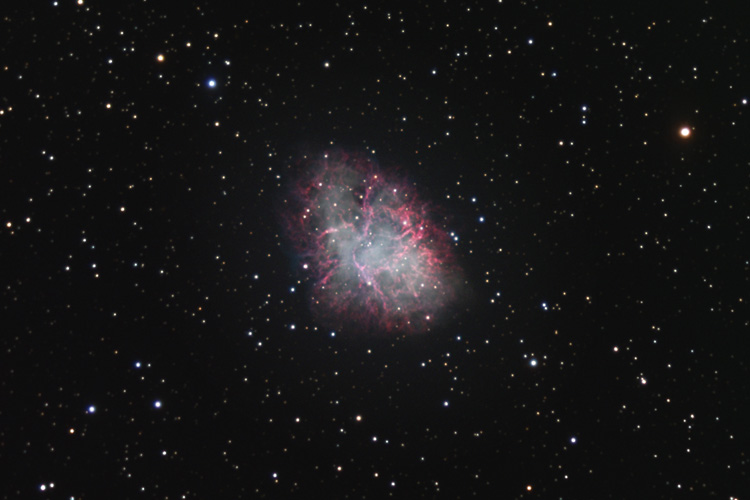
The Crab Nebula, M1
To see the faint detail in this
image, adjust your monitor's brightness and contrast to clearly show all 17
steps in this grayscale chart:
![]()
Click here to see a larger image: M1 (1200x800 pixels)
- Telescope:
Celestron C11, 11" f/10 Schmidt-Cassegrain at f/6.0
- Zeiss
II German Equatorial Mount
- Santa
Barbara Instrument Group ST-8E NABG CCD camera (1530 x 1020 pixels, 9 x 9mm, monochromatic, 16 bit, 13.8 x 9.2mm array)
- CWF8
color filter wheel with Ha and IR-blocking red, green and blue dichroic filters
Exposure Information:
- Date:
Friday November 1, 2002
- Location:
Mt. Pinos, CA
- Elevation:
Approx. 8300', OAT +29F
- CCD
operating temperature: -30C
- Composition:
RRGB 170:170:50:110 minutes. Total exposure time: 330 minutes
- All
subexposures were 10 minutes each, unbinned
- Plate
scale: 1.1 arc-sec/pixel
About
The Crab Nebula
The
first entry in Charles Messier's list of non-comets
is the Crab Nebula, a supernova remnant in the constellation Taurus. According
to Chinese records that may have chronicled the stellar explosion that gave
birth to this nebula, the supernova occurred on July 4, 1054 AD. The supernova
was visible in the daytime for twenty-three days before fading from view.
"For a few weeks the star was blazing with the light of about 400 million
suns" according to Robert Burnham Jr.
Today,
amateur astronomers can observe (and photograph) this fiery wonder through toy
telescopes and marvel at this amazing object. During its 948-year lifetime, M1
has grown to a diameter of about 6 light years and is expanding at over 600
miles per second. Comparisons of photographs of the nebula taken several years
apart reveal the rapid expansion of the nebula.
At
the core of the Crab Nebula lies a rapidly-spinning neutron star formed when
the supernova explosion compressed the core of the original star into a
super-dense state of matter. The neutron star is thought to be only a few miles
in diameter and it spins at approximately 1800 RPM. (That's commensurate with
the rotational speed of an automobile engine at freeway speeds.)